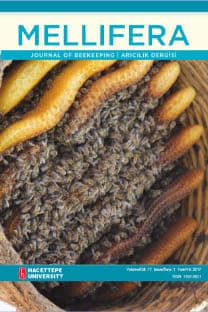The role and the importance of the family Halictidae (Apiformes: Apoidea) in pollination of natural and agricultural vegetation
Tarımda ve organik tarımda tozlaştırıcı arılara duyulan ihtiyaç ve bunların ekonomik önemi büyüktür. Halictidae familyası ise tozlaştırıcı arı (Apiformes:Apoidea) grupları içindeki en büyük familyalardan biridir ve kozmopolit olarak tüm kıtalarda geniş bir yayılım göstermektedir. Bu derleme çalışmasında, Halictidae familyasının tarımda ve doğal vejetasyon üzerinde tozlaştırıcı etkisi ele alınmaya çalışılmış ayrıca genel olarak yaban arılarının ve tekil (soliter) arıların da bu konudaki rolleri tartışılmıştır. Özellikle sosyal yaşam konusunda oldukça çeşitlilik sergileyen ve belki de bu yüzden geniş bir beslenme rejimine sahip olan Halictidae familyasının aynı zamanda geniş bir yayılım göstermesi, tür zenginliği ve tür çeşitliliği göz önünde tutularak tozlaşma çalışmalarında önemle dikkate alınması gerektiği vurgulanmaktadır.
Tarımsal ve doğal vejetasyonun tozlaşmasında Halictidae (Apiformes: Apoidea) familyasının rolü ve önemi
The need and the economic value of using pollinator bees in organic farming and agriculture in general have been arisen. Halictidae is one of the biggest groups throughout the pollinator bees and it is widely distributed in all continents. In this review, we tried to discuss the role and the importance of members of the family Halictidae in pollination of natural and agricultural vegetation. Besides, the importance of wild bees and also the solitary bees in this topic have discussed. As a summary, we emphasized the disregarded role of Halictidae in pollination. Because of three reasons, Halictidae might be very important in pollination studies: one is they are generally collecting pollen from a wide range of flowering plants. The others are, they are very cosmopolite (abundant) and exhibit a very large diversity.
___
- 1. Kremen, C., 2001; Organic Farming Research Foundation, www.ofrf.org, Project Report No: 99-07 Conserving and restoring pollination services in organic farms of Yolo and Solano Counties, Northern California.
- 2. Williams, I. H., 2002; Insect Pollination and Crop Production: A European Perspective, Pollinating Bees-The Conservation Link between Agriculture and Nature - Ministry of Environment / Brasília, p.59-65
- 3. Pesenko Yu. A., Banaszak, J., Radchenko, V.G., Cierzniak, T., 2000; Bees of the family Halictidae (excluding Sphecodes) of Poland: taxonomy, ecology, bionomics. Bydgoszcz,Poland: Bydgoszcz Press, pp. 1-348.
- 4. Michener, C. D., 2000; The Bees of The World, John Hopkins Univ. Press, Balitimor, USA.
- 5. Özbek, H., 2002; Arılar ve Doğa, Uludağ Arıcılık Dergisi, Ağustos, 2002, s. 22-25
- 6. TÜBİTAK, 2005; Türkiye Taksonomik Tür Veritabanı http://biow.tubitak.gov.tr/present/taxonForm1.jsp
- 7. Dikmen, F., 2006; Systematic Studies on the Family Halictidae (Apoidae: Hymenoptera) of The City Aankara and its Surrounding Area, H.U. Institute of Science, Master Thesis, Ankara, pp.125.
- 8. Dikmen, F. ve Çağatay N., 2007; Ankara’daki Tozlaştırıcı Arılardan Halictidae (Apiformes: Apoidea: Hymenoptera) Familyası Üzerine Faunistik Çalışmalar, Uludağ Arıcılık Dergisi, 7:3 (94-101) Ağustos 2007.
- 9. Nabhan, G. P., 1998; The potential consequences of pollinator declines on conservation of biodiversity and stability of food crop yields, Conservation Biology 12: 1, 8-17.
- 10. Shelly, T. E., 2000; Buzzing Bees (Hymenoptera: Apidae, Halictidae) On Solanum (Solanaceae): Floral Choice and Handling Time Track Pollen Availability, Florida Entomologist 83 (2); 180-187.
- 11. Klein, A.M., Steffan-Dewenter, I., Tscharntke, T., 2003; Fruit set of highland coffee increases with the diversity of pollinating bees, Proc. R. Soc. Lond. B 270, 955–961.
- 12. Batra, S. W. T., 1995; Bees and pollination in our changing environment, Apidologie, 26: 361-370.
- 13. Klein, A. M., Vaissière, B. E., Cane, J., Steffan- Dewenter, I., Cunningham, S. A., Kremen, C. and Tscharntke, T. 2007; Importance of pollinators in changing landscapes for world crops. The Proceedings of the Royal Society of London, Series B. 274, 303-313.
- 14. Food and Agriculture Organization of the United Nations (FAO), 2004; Conservation and Management of Pollinators for Sustainable Agriculture - The International Response Pp.19-27 in Solitary Bees: Conservation, Rearing and Management for Pollination (Freitas, B.M. and Pereira, J.O.P., eds.), Beberibe, Ceara, Brazil.
- 15. Dias, B.S.F., Raw, A. & Imperatri-Fonseca, V.L., 1999; International Pollinators Initiative: The Sao Paulo Declaration on Pollinators. Report on the Recommendations of the Workshop on the Conservation and Sustainable Use of Pollinators in Agriculture with Emphasis on Bees, Brazilian Ministry of the Environment, Brazil, 79pp.
- 16. Schneider, E. L., 1982; Notes On The Floral Biology Of Nymphaea elegans (Nymphaeaceae) In Texas, Aquatic Botany, 12: 197-200.
- 17. Singer, R. B., 1999a; The pollination mechanism in southern Brazilian orchids which are exclusively or mainly pollinated by halictid bees, Plant Systematics and Evolution 217: 101-107.
- 18. Singer, R. B., 1999b; The pollination mechanism in the ‘Pelexia alliance’ (Orchidaceae: Spiranthinae), Botanical Journal of the Linnaean Society, 131: 249–262.
- 19. Singer, R. B., 2001; The pollination mechanism of three sympatric Prescottia (Orchidaceae: Prescottinae) Species in Southeastern Brazil, Annals of Botany 88: 999-1005.
- 20. Goubara, M. and Takasaki, T., 2004; Pollination effects of the sweat bee Lasioglossum villosulum trichopse (Hymenoptera: Halictidae) on genic male-sterile lettuce. Appl. Entomol. Zool. 39 (1): 163–169.
- 21. Al-Ghzawi, A., Zaitoun, S., Mazary, S., Schindler, M. & Wittmann, D., 2006; Diversity of bees (Hymenoptera, Apiformes) in extensive orchards in the highlands of Jordan. Arxius de Miscel•lània Zoològica, vol. 4.
- 22. Batra, S. W. T. 1984; Solitary bees. Scientific American 259:120-127.
- 23. Goulson, D., 2003; Conserving wild bees for crop pollination, Food, Agriculture & Environment, 1(1), 142-144.
- 24. Freitas, B., M,. and Pereira, J., O., P., (eds.), 2004; Solitary Bees: Conservation, Rearing and Management for Pollination, Beberibe, Ceara, Brazil.
- 25. Secretariat of the Convention on Biological Diversity, 2005; Handbook of the Convention on Biological Diversity Including its Cartagena Protocol on Biosafety, 3rd edition, Montreal, Canada, ISBN: 92- 9225-011-6.
- ISSN: 1302-5821
- Başlangıç: 2001
- Yayıncı: Hacettepe Üniversitesi
Sayıdaki Diğer Makaleler
Aslı özkök TÜYLÜ, Kadriye SORKUN
Effect of the propolis on the performance and carcass characteristics of growing quail
Mürsel KARABACAK, Soner ÇANKAYA, Elçin BALCI, Sibel SİLİCİ
Erythrocytes functional parametres changing under apitherapy of neurological patients
V.N. KRYLOV, A. V. GOUSTOV, A. V. DERIUGINA, E. A. ANTIPENKO
